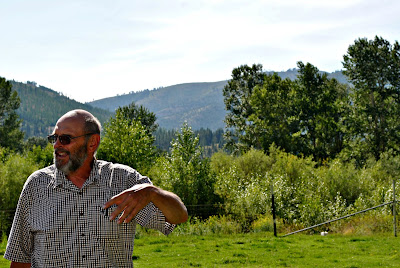“If you’re going to
have a work family, this is a good one to have.”
Creating this warm sense of place within an office setting
is certainly no easy task. Doing so requires a certain skillset and mentality
that helps to accommodate diverse personalities and work styles.
These staff
members make Missoula County great and we are immensely fortunate to have them.
If you walk into the Community and Planning Services office,
a friendly face will be there to greet you.
After even a brief conversation, it becomes evident that Office Manager,
Laurie Hire, is exceptionally knowledgeable, curious and helpful. Having the
opportunity to work with her, it is even more evident that she is an incredible
person and helps to make our Community and Planning Services department (CAPS)
a special place.
Having worked at the County since 2005, Laurie has come to
know many individuals and processes well. However, it was a unique and
unplanned situation that initially brought her here.
“I was working at the Missoulian when a friend left for a
job in Justice Court. She called me the next day to say that the job wasn’t for
her and that I should do it,” Laurie said.
It was at this time that Laurie was hired as a temporary clerk
to migrate civil files into newly purchased software. After a year of work,
Laurie was hired full time as a judicial aide and worked in that office for
four years.
“I was able to bring my boys to work after they were born
which helped to bring some happiness into the office. I enjoyed my time there
but after a while I was interested in other opportunities at the County.”
It was at that time that Rural Initiatives was hiring for an
Administrative Aide. The position was a perfect fit for Laurie where she could
use her journalism and graphic design background.
“I knew I didn’t want to leave the County but that I wanted
to do work that more closely aligned with my degree. This position offered
outreach and to work on publications.”
When the Office of Planning and Grants went through a restructuring
process, Laurie’s position grew into her current role where she works on a
variety of things including the eNewsletter, brochures and redesign of both the
RI and CAPS logos.
Now, as CAPS Office Manager, Laurie ensures the daily operations
of the office run smoothly. She connects with the public through outreach
efforts, including email correspondence, website updates and drafting the CAPS
newsletter. Laurie also pulls together all CAPS budget reports, pays bills,
edits letters and takes minutes for meetings.
“I’ve gotten to know everyone really well and make sure that
they have what they need to accomplish their work. When we transitioned into
CAPS it took time to develop working relationships with new staff. I wanted to
step in to find ways to bring people together and to have fun.”
Aside from these duties, Laurie works very closely with
community councils in providing administrative support. She is there to answer
questions about how meetings should be run and conducted, translates agency
jargon, maintains the handbook and supports their activities.
“Councils are a valuable part of our department and Missoula
County. They’re the eyes and ears of their community and in turn help us share
our message with that community.”
With such a wide array of responsibilities, Laurie enjoys
outreach work to be able to provide information to the community while sharing
CAPS’ projects. The most rewarding aspect of her role is knowing that in some
way or another she is making someone’s job easier.
“We have a good staff. They’re fun and easy to work with.
Everyone is professional, responsible and fun. I could not do my job without
Genevieve [MacDonald] and am so thankful to work with her.”
Outside of work, Laurie enjoys many hobbies including
reading and spending time with her husband and two sons. In fact, Laurie’s
husband, Sean, also works for the County. They met in French class while
attending the University of Montana and have been married since 2004.
Although Laurie wanted to be a creative writer as a child –
and still enjoys doing so when she has the time – Laurie is happy with her
career choice and to be working for the County.
“I’m in a really great place. It’s not what I thought I
would be doing but I have the flexibility to take care of my family and myself.
I have fun here which makes it enjoyable and rewarding. Missoula County really
looks out for each other. I don’t think people fully understand how much the
County values staff. Feeling support by your coworkers and elected officials is
something really special.”
Favorite Book: I
love everything from Camus to David Sedaris. My mom was an English teacher.
Favorite Movie: Star
Wars trilogy, Breakfast at Tiffany’s, Shawshank Redemption.
Favorite Color: I
love color in general, so The Pantone chart.
Favorite TV Show:
I Netflix binge and can watch Arrested
Development and Deadwood over and over again.

